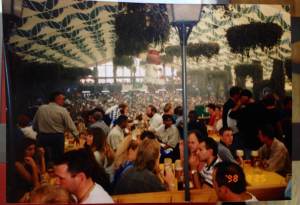Oktoberfests seem to be a dime a dozen these days – I believe there are at least 20 during the next month in the Commonwealth of Massachusetts alone. It was my luck – or misfortune – that my first Oktoberfest was the real one, in Munich, probably around the same time I had my first Berliner Weisse. For all of you who truly would like to appreciate your next Oktoberfest, my undergraduate German minor self has volunteered to share the history of the original festival and the standards it sets for its beer.
Oktoberfest postcard, 1998
The original Oktoberfest celebrated the October 12, 1810 nuptials of Crown Prince Ludwig, later known as King Ludwig I, to Princess Therese of Saxony-Hildburghausen. What was particularly special, and rare, about the occasion was that the royals condescended to invite the public to celebrate with them on the fields in front of the Munich city gates. These fields were dubbed Theresienwiese (“Theresa’s fields”), but over time locals abbreviated the name to “Wies’n.” That first Oktoberfest featured horse races at the close of the event.
The Oktoberfest continued in 1811, with the entertainment committee adding an Agricultural Show added to the horse races. Over time the number of amusements grew, including carousels, swings, and beer stands. By 1896, those beer stands were replaced by beer tents and halls that backed competing breweries. There were so many amusements by 1960 that the horse races were eliminated from the festival.
This year marks the 181st Oktoberfest. Today, the festival draws about 6 million visitors and lasts about 16 days (depending on which day October 3, German Unification Day, falls), from late September to the first weekend in October. Since 1950, a twelve gun salute and the tapping of the first keg by the incumbent Mayor of Munich, who declares, “O’zapft is!” (that’s a Bavarian dialect), has signaled the opening of Oktoberfest.
Only beer conforming to the Reinheitsgebot and brewed within the city limits of Munich may be served at Oktoberfest. These beers are designated as “Oktoberfest Beer,” a registered trademark of the Club of Munich Brewers, and include Augustiner-Bräu, Paulaner, Hacker-Pschorr-Bräu, Spatenbräu, Löwenbräu, and Staatliches Hofbräu-München. These brews were traditionally brewed in March, when it was sufficiently cool to prevent bacterial contamination of the batch, with higher alcohol content to preserve it through the summer. Modern technology now allows for this “Märzenbier” to be brewed at the end of summer. In 2013, revelers consumed 6.7 million liters of this beer, down from 6.9 liters in 2012. Correspondingly, the number of brawls involving beer glasses fell from 66 to 58, and the number of Bierleichen (“beer corpses,” people who drink themselves unconscious) treated dropped from 800 to 638.
Inside the Hofbräu tent, circa 1998
My undergraduate German minor self can now rest assured that you are all prepared for the vast array of upcoming Oktoberfests. You can make an educated decision on which beer to drink and even share some fascinating factoids with your friends. All that’s left to do is raise your Stein and say “Prost!”


